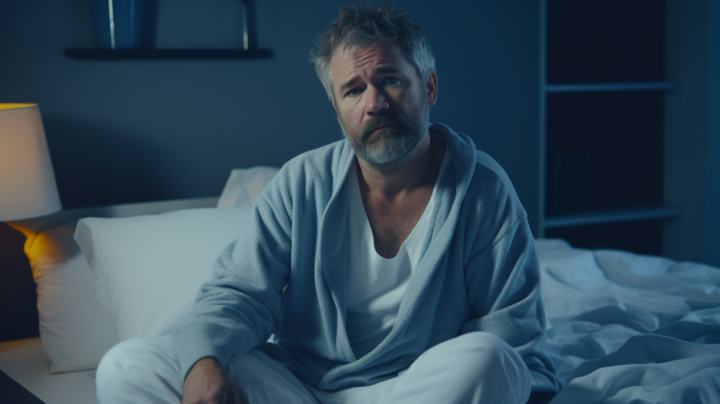
Sleep, that elusive treasure in our turbo-charged lives, often plays hard to get. For those of us searching for a gateway to better rest, a hot tub soak before bed might just be the answer. It turns out, marinating yourself in warm, bubbly water can do wonders for your sleep quality. Let’s explore how integrating a hot tub routine before bedtime can enhance your sleep.
I’ve had a hot tub for several years now. My decision to get one wasn’t influenced by any sleep-related benefits. However, I couldn’t help but notice a pattern: every time I came inside after a soak, a wave of drowsiness would wash over me. It also seemed like my sleep quality improved on those nights. My curiosity was sparked, leading me to delve into some research to understand the potential link between hot tub use before bed and better sleep.
Hot Tub Before Bed: Why This Evening Ritual Helps Us Sleep
1. What the Science Says
The scientific evidence linking the use of hot tubs for body heating with improved sleep quality is well-established. A soak in a hot tub before bed has been conclusively shown to improve both sleep onset and depth.
How? An internal clock in our brain regulates our sleep and body temperature on a 24-hour cycle, dictating when we feel sleepy or awake. Climbing into a hot tub can make us feel sleepy because it helps control this cycle, signaling to our bodies that it’s time to hit the hay.

Your Body’s Circadian Rhythm and Temperature
Our body temperature follows a daily rhythm where it’s higher in the late afternoon and lowest during sleep. Typically, one’s core temperature drops slightly before bedtime, reaching a minimum during the night, and then starts to increase, serving as a natural wake-up signal.
Immersing in warm water can help lower your internal temperature post-soak, signaling to your body it’s time to sleep. It conclusively improves:
- sleep efficiency (the ratio of actual sleep time compared to the total time spent in bed with the intention of sleeping)
- sleep onset latency (duration it takes to transition from being fully awake to sleeping)
“Body temperature, which is involved in the regulation of the sleep/wake cycle, exhibits a circadian cycle, being 2-3 degrees Fahrenheit higher in the late afternoon/early evening than during sleep, when it is the lowest. The average person’s circadian cycle is characterized by a reduction in core body temperature of about 0.5 to 1 F around an hour before usual sleep time, dropping to its lowest level between the middle and later span of nighttime sleep. It then begins to rise, acting as a kind of a biological alarm clock wake-up signal. The temperature cycle leads the sleep cycle and is an essential factor in achieving rapid sleep onset and high efficiency sleep.”
The University of Texas – “Take a Warm Bath 1-2 hours Before Bedtime to Get Better Sleep, Researchers Find”
Soaking in a hot tub activates the body’s mechanism for regulating heat, significantly boosting blood circulation from the core to the extremities. The warm water dissipates your body’s heat and lowers your core temperature. Thus, immersing in a hot tub about 1-2 hours before sleep time complements the body’s natural sleep cycle, enhancing the likelihood of not just falling asleep more swiftly but also enjoying a higher quality of rest.
2. A hot tub’s warmth, buoyancy, and jet massage work together to relax both our body and mind.
Sitting in a hot tub not only eases our muscles and joints but also helps to dissolve the day’s tensions. It eases the strain on every part of our body, melting away any lingering stress.
3. Hot tubs encourage relaxing behaviors.
To prepare for sleep, sleep specialists often suggest a clear mind free from distractions, emphasizing the importance of putting aside cell phones and other gadgets. Hot tubs naturally enforce this advice by creating an environment where electronics must be kept at bay, encouraging individuals to fully engage in the moment and the soothing effects of the soak.
4. Alleviating pain promotes better sleep.
20% of US adults suffer from chronic pain. We don’t need an expert to tell us that pain makes sleeping more difficult. Fortunately, hot tubs are effective at alleviating some common types of pain by pushing lactic acid out of your muscles. Spending time in a hot tub can make it easier to find a comfortable sleeping position and enjoy restful sleep without discomfort.
The Perfect Hot Tub Routine for Better Sleep
Time Your Soak
For optimal sleep benefits, soaking in a hot tub 60 to 120 minutes before bedtime can significantly impact sleep quality, giving your body enough time to cool down.
Use Ideal Water Temperatures
Consider a water temperature range of 100°F to 104°F (37°C to 40°C) ideal for a relaxing soak without causing the body to overheat.
Don’t Stay in too Long!
A 20 to 30-minute session is sufficient to reap the sleep-promoting benefits without risking dehydration or overheating.
Maximizing the Benefits: Tips and Tricks
Ambient Setting: Lights and Sounds
Creating a relaxing ambiance with dim lights and soft, soothing sounds can further promote relaxation and readiness for sleep.
Post-Soak Care
First rinse off under warm water. While a cold shower may appeal to some, it can inadvertently elevate your body temperature, reversing the benefit achieved in your soak. Next, make sure you drink a bit of water to stay hydrated. If you limit your soak to 20 or 30 minutes, you won’t need much (you don’t want to have to take a trip to the bathroom in the middle of the night!)
Climb into bed and get comfortable!
One more thing: When you climb into bed, we recommend buckwheat pillows for optimal neck and head support!
Try improving your sleep with a soak in your hot tub before bed tonight!
The ritual of soaking in a hot tub before bed offers proven benefits to those seeking to enhance their sleep quality. By following the tips and considerations outlined, individuals can safely incorporate this practice into their nighttime routine, potentially transforming their sleep.
We’d love to hear from you. Share your experience with your hot tub and sleep in the comments below!

What is Deep Pressure Stimulation?
Imagine the serene and cozy feeling of waking under a heavy down comforter on a winter morning. That sense of relaxation isn’t just from the warmth; it’s a result of the weight of the blanket. The consistent and even pressure on your body affects your nervous system, a phenomenon known as Deep Pressure Stimulation (DPS).
Deep Pressure Stimulation involves applying a firm yet gentle pressure to the body. This pressure activates the parasympathetic nervous system. This phenomena has been developed into a therapeutic tool that has been proven to foster a calmer, happier state of mind and can notably improve sleep quality.
Deep Pressure Stimulation can:
- boost “happy hormone”‘ serotonin levels,
- reduce the “stress hormone” cortisol, and
- increase melatonin, which is involved in synchronizing circadian rhythms, including sleep
Whether through holding, hugging, squeezing, or swaddling, DPS can make individuals feel more relaxed and ready for rest, enhancing their overall sleep experience. Initially designed to help individuals with sensory processing disorders like ADHD, DPS has now found broad applications in commercial products for the general populace.
DPS in Sleep Products: Weighted Blankets and Pillows
Weighted Blankets
Weighted blankets are the most popular DPS products in the sleep industry. Designed to be 10-12% of your body weight, these blankets provide a distributed pressure across your body, offering the therapeutic benefits of DPS. Users often report feeling more secure and calm, leading to quicker sleep onset and fewer nighttime awakenings.

Weighted Pillows
Weighted pillows are filled with dense materials like buckwheat hulls, offering both comfort and versatility. Ideal for both sleep and daytime relaxation, they bring a soothing presence to any space. Like weighted blankets, they apply an even and consistent pressure that can soothe tension when held close.
Additionally, buckwheat pillows excel in their traditional role as bed pillows.
The natural firmness and adaptability of the buckwheat hull filling conforms perfectly to the shape of your head and neck, providing personalized support that lasts all night. Buckwheat pillows’ unique characteristics help in reducing common issues like neck pain and stiffness.

Eco-Friendly and Natural Options
For individuals looking for natural and eco-friendly options to enhance their sleep, buckwheat pillows are a great choice. These pillows resonate with principles of sustainable living, making them a well-rounded, environmentally conscious option for improved sleep.
Embrace Restful Nights
Incorporating Deep Pressure Stimulation into your nightly routine with products like weighted blankets and buckwheat pillows can significantly enhance your sleep quality. As we become more aware of the essential role sleep plays in our overall health, turning to these innovative, natural, and eco-friendly solutions is a smart and effective choice for improving restfulness.

My wife and I stayed overnight at my sister’s house last weekend. My sister enthusiastically pointed to the new Casper mattress in the guest bedroom. “We just got this, let me know what you think!”
It seemed great at first, but late that night I woke up with an ache in my hip. Like most people, I’m a side sleeper, so I just rolled over to relieve the discomfort. Unfortunately after an hour or two, I woke up again with an ache in my other hip. All night I tossed and turned.
While lying awake, I wondered if I should try sleeping on my back. I’d tried to change my sleep positions before, without much luck. I gave it a go, but got a quick elbow from my wife. “You’re snoring!”
When I got home, I did some research. Why did this particular mattress make my hips hurt? It seemed perfectly comfortable when I went to bed that night.
After some reading, I learned that both firm and soft mattresses can cause hip pain. Nothing is ever simple…
Firm Mattress Hip Pain
Many prefer a firm mattress because they believe it offers better support. However, sleeping on an excessively firm mattress, especially if you’re a side sleeper, can lead to hip pain. The firm surface creates pressure points on your hips, restricting blood flow and causing discomfort. This pressure can often lead to pain, numbness, and tingling in the hip area. Fortunately, this type of discomfort typically dissipates quickly when you change your sleeping position or adjust your mattress.
Soft Mattress Struggles
On the other end of the spectrum, sleeping on an overly soft mattress can also contribute to hip pain. A soft mattress allows your hips to sink too deeply, causing your hips to flex outside of their natural range of motion. This deviation can lead to misalignment issues, which can result in pain and stiffness over the course of the night. Unlike pressure point pain, the discomfort caused by alignment issues may not become noticeable until you have slept for a few hours or wake up in the morning.
Hip pain from side sleeping can be resolved with a softer or firmer mattress.
I couldn’t tell if my sister’s new memory foam mattress was too soft or too firm for me. It felt great when I initially climbed into bed. Even when the ache set in, I wasn’t sure what was causing it.
When I returned home to my own supremely-comfortable mattress (a really old Kingsdown), it became evident that the Casper mattress was firmer, mostly b/c it was lacking the soft pillow top that my mattress had. Thus I had to conclude that my body needs a softer mattress type. That’s a good thing to know, b/c my wife just ordered a king-size frame and we’ll be in the market for a good mattress in a few weeks!
Finding the Right Balance
So, what’s the solution? Unfortunately it’s not a simple task to find the right mattress. There is no single type that’s just right for everyone. Here are some tips to help you choose the right one:
- Consider Your Sleep Position: Your preferred sleep position plays a significant role in determining the ideal mattress firmness for you. Side sleepers like myself often require a softer mattress to cushion the hips, while back or stomach sleepers might benefit from a firmer surface.
- Test Before You Invest: Before making a purchase, take the time to test out different mattresses in a showroom. There’s no substitute for trying it in person. Lie down in your typical sleep positions and gauge the comfort level to determine if it suits your needs. While many of the internet retailers will take returns, it’s often not easy and the mattresses often end up in a landfill.
- Pay Attention to Support: A mattress should provide adequate support to maintain proper spinal alignment (straight and parallel to the ground) while allowing your hips and shoulders to sink slightly for pressure relief. Look for a mattress that maintains this balance.
- Read Reviews: Online reviews and testimonials from other consumers can provide valuable insights into how different mattresses perform in terms of comfort and support.
- Consult with a Professional: If you’re experiencing chronic hip pain, it’s advisable to consult with a healthcare professional or orthopedic specialist who can offer guidance on the best mattress for your specific needs.
Hip pain from sleeping is a common issue that can often be traced back to the mattress you sleep on. Whether it’s the pressure points caused by a firm mattress or the misalignment from a soft one, finding the right balance is key to a restful night’s sleep. By considering your sleep position and testing mattresses before purchasing, you can make an informed choice that supports your hip health and overall well-being. Remember, the path to better sleep and less hip pain begins with the right mattress.
